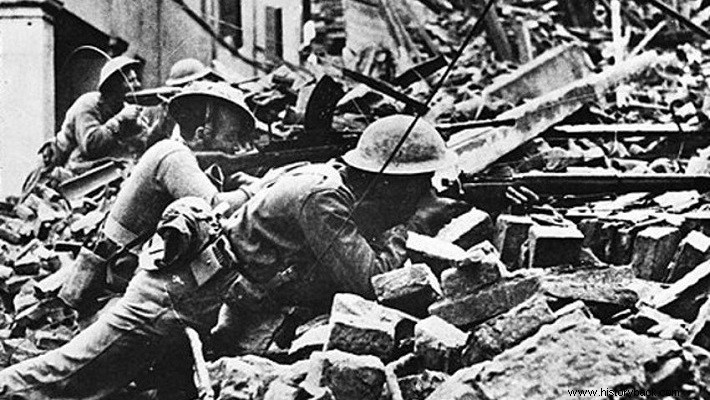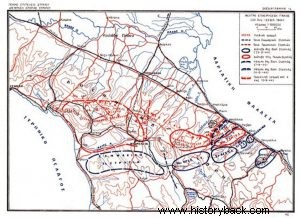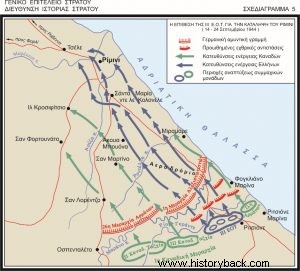
The 3rd Greek Mountain Brigade was formed on May 31, 1944 in Insariyeh, Lebanon, where it was trained in mountain combat. It had a total strength of 3,377 men and included three Infantry battalions, the III Field Artillery Regiment, an Engineer company, a Transport section, a Field Surgery section, a Reinforcements company, a Military Group and Administrative Support sections. Its commander was Infantry Colonel Thrasyvoulos Tsakalotos.
On August 11, 1944, the Brigade was transferred from the port of Haifa in Italy, to the port of Taranto, by the ocean liner "Ruiz" and advanced by road and rail to Spoleto and then to the Catolina area, in order to take part in the Allied operations, with the objective of breaking the line of the Northern Apennines, the so-called "Gothic Line".
The German plan for the containment of the Allied troops in Italy had been determined by Hitler himself since July 1943. It provided for the abandonment of any sector south of the "Gothic Line" and the defensive installation on its southeastern approaches. The fortification works of the "Gothic Line", whose total development was about 350 kilometers, began in September 1943.
On 3 September 1944, III EOT was placed under the command of the 5th Canadian Division and ordered to move to the Santa Maria Pietrafitta area, eight kilometers from the front line. On the same day, the Brigade Artillery Regiment moved to the Metauros River area and joined the artillery of the 1st Canadian Army Corps. On 5 September, the Brigade's artillery began its campaign by taking part in the attack by fire on the enemy position of Coriano (west of Riccione).
The entry of the Brigade into the zone of operations and its participation in the artillery contest was greeted with great enthusiasm. The Greek artillery continued its action over the next two days and fired a total of 3,648 explosive shells against enemy targets in the Koriano location, while also offering the first sacrifices with the wounding of three gunners, one of whom lost his life.
The defensive site was covered by bushes and cultivated land having – perpendicular to the attack directions – water lines, i.e. rivers and streams. It was strongly organized, with varied trenches, artillery and minefields. From midnight on the 9th to the 13th of September, intense enemy activity developed with enemy aircraft flying and attacking, curveball weapons as well as patrol activity on both sides.
The attack on Rimini, on 14 September, was undertaken by the 1st Canadian Division, under which the 3rd Brigade belonged. This was concentrated south of the Marano River with the aim of advancing beyond it and with an aggressive movement to the north-west, to act in a circuit from the west, towards Rimini. The Germans, with parts of the 1st Parachute Division and the Turkoman Division, occupied the heights north and northwest of the river.
The Hellenic Brigade was ordered to launch a night attack against the enemy location. Its zone of activity was determined between Via del Fiume and Via 16, with the ultimate goal of capturing the city of Rimini. Her attack would be covered on the left by the 3rd Canadian Brigade and on the right by the 41st Canadian Dragoons.
The Brigade's plan of operations provided for the attack at different times to first clear the enemy forces on the left of the formation to avoid flanking and the successive strong support of Artillery in three directions, with the 3rd Battalion under Major Andreas Louterakis, from 00:30 to Batara – Casa Maltoni, the 1st Battalion under Major Ioannis Karavia, from 02:00 to Casa Monaltini, the 2nd Battalion under Major Sophocles Tzaneti from 03:45, acting towards Casa Nodicelli.
Despite stubborn German resistance, on the evening of September 14, the Greek divisions achieved their objectives. On September 15, the Brigade, continuing its advance with undiminished intensity, occupied the line Casalecchio - Southwest Corner of Rimini Airport - Marano River Bridge, while in the following two days, the Greek forces managed to bend the German resistance and occupy the airport . On September 19, the Greeks together with the Canadians crossed the Rodella River and headed for Rimini. The next day the main Greek attack was launched to capture the city.
The battalions would act with speed to capture Rimini. Specifically, the 2nd Battalion would occupy the eastern part of the city, from the railway line to the coast, the 3rd Battalion its center and the 2nd Battalion would bypass it from the western edge. Immediately after, all three battalions would occupy and secure the bridges over the Marekia River, on the northern outskirts of the city.
At 06:45 on 21 September the 2nd Battalion reached the Auza River in the center of the city. In a short time he neutralized local islands of resistance that the Germans had left to aid their retreat and entered the city at 07:15, captured the City Hall with a company and raised his war flag there. At the same time, the 3rd Battalion advanced towards the location, which it occupied.
At 07.30 the mayor of Rimini presented himself to the Commander of the 2nd Company of the 3rd Battalion, Captain Apostolaki Michael and informed him that he is ready to hand over the city to the Greek forces by drawing up a relevant protocol. "In Santa Maria de la Colonelli, today the 21st of September, day of the week Thursday of the year one thousand nine hundred and forty-four (1944) and at 7.30 the undersigned committee consisting of Bortoni Goberio as President and Bortoni Romolo Del Prato Banzio, as members of the anti-fascist party for the liberation of the city (of the others who left it) presented to the advancing Greek forces, namely to the Commander of the 2nd Company of the 3rd Battalion III EOT, Captain Apostolakin Michael. We surrender the city of Rimini unconditionally. The maintenance of order and the protection of the population is left to the Greek forces."
After being drawn up in Greek, Italian and English, the protocol was signed and considered by the Commander of the 3rd Battalion. Thus, from 09:00 on September 21, 1944, Rimini was under the complete control of the Greeks. During a ceremony held in the city, the Battle Flag of the 2nd Battalion was honored and the III Brigade was given the honorary name "Rimini Brigade". From 27 September to 16 October 1944 the Brigade successfully continued its offensive operations, this time under the new command of the 2nd New Zealand Brigade, and then withdrew from Italy, returning to the now free Greece on the steamship "Alcantara". .
The losses of the III EOT, from its entry into operations in Italy until the capture of Rimini, amounted to 6 officers and 72 men killed and 19 officers and 169 men wounded, i.e. 10% of the total force or 20% of the battalions infantry who bore the brunt of the struggle. The magnitude of the losses shows the effort expended, the value of the executives and the faith of everyone for the victory.
The Commander of the 2nd New Zealand Division Sir Berrnard Freyberg in the special daily Order of 20 October 1944 stated among other things:"It is with great sadness that we say goodbye to the 3rd Greek Mountain Brigade. In Italy, fighting bravely and successfully, you have won a reputation of which you can justly be proud. When the 3rd Greek Mountain Brigade was placed under my command I accepted it as an honor […]. By your exploits at Rimini and Rubicon you have added another page to the glorious History of your Army; and you have shown yourself worthy of the great traditions of the Nation which has always believed that "Freedom means Happiness" [...]. You are now leaving Italy for your native land. Taking together
our heartfelt wishes, not only for the Greek Army, but also for the Greek People for whom we have a deep and eternal appreciation. Good luck and God willing from all the officers and men of the 2nd New Zealand Division.' Moreover, the commander of the Allied troops Alexander in his report entitled "The Allied armies in Italy from September 3, 1943 to December 12, 1944", noted about the action of the Brigade:"On September 20, after a hopeless struggle, San Fortunato was cleared and during the night the Greeks, under the command of the 1st Canadian Division, entered Rimini. I was
happy, because this success had so timely brightened the fortunes of that heroic country, which had been the only fighting ally at our side in gloomy times, and because a new victory in Italy had been added to the glory gained in the mountains of Albania." The Greeks in the battle of Rimini waged a fierce struggle against an enemy well-equipped, with strong fortifications, and only heroism and self-sacrifice led them to the victorious result. The capture of the city facilitated the Allied advance towards the Rubicon River and contributed decisively to the liberation of the Italian peninsula.


SOURCE:army.gr
